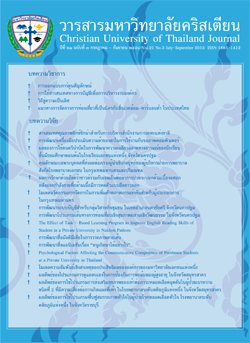โมเดลนวัตกรรมการจัดการในการเพิ่มศักยภาพการแข่งขัน สำหรับผู้ประกอบการในกรุงเทพมหานคร
บทคัดย่อ
การวิจัยครั้งนี้มีวัตถุประสงค์เพื่อศึกษาและวิเคราะห์องค์ประกอบของโมเดลนวัตกรรมการจัดการในการเพิ่มศักยภาพการแข่งขันสำหรับผู้ประกอบการในกรุงเทพมหานคร กลุ่มตัวอย่าง คือ ผู้ประกอบการในกรุงเทพมหานคร จำนวน 384 คน ได้มาโดยการสุ่มแบบหลายขั้นตอน สถิติที่ใช้คือ การหาค่าความถี่ ค่าร้อยละ ค่าเฉลี่ยส่วนเบี่ยงเบนมาตรฐาน ค่าสัมประสิทธิ์สหสัมพันธ์แบบเพียร์สันและการวิเคราะห์เส้นทางอิทธิพล (Path Analysis) เครื่องมือวิจัยเป็นแบบสอบถาม มีค่าดัชนีความสอดคล้อง (Index of Item-Objective Congruence : IOC) เท่ากับ 0.86 ค่าสัมประสิทธิ์แอลฟาครอนบาค (Cronbach's alpha coefficient) เท่ากับ 0.96 และการวิเคราะห์ องค์ประกอบเชิงยืนยัน (Confirmatory Factor Analysis) ในการวิเคราะห์ข้อมูล
ผลการวิจัยพบว่า โมเดลนวัตกรรมการจัดการในการเพิ่มศักยภาพการแข่งขันสำหรับผู้ประกอบการในกรุงเทพมหานคร มีองค์ประกอบ 4 ด้าน ประกอบด้วย 16 ปัจจัย ทั้งนี้มีค่าน้ำหนักองค์ประกอบ () ของทุกองค์ประกอบของแต่ละปัจจัย ที่นัยสำคัญทางสถิติที่ระดับ .01 (
) มีค่าอยู่ระหว่าง 0.86-0.98 ต่ละตัวแปรมีค่า อยู่ระหว่าง 0.73-0.95 และโมเดลปัจจัยเชิงสาเหตุที่ส่งผลต่อศักยภาพตามสมมติฐานมีความสอดคล้องกลมกลืนกับข้อมูลเชิงประจักษ์ (x2=142.76, df=99, x2df=1.44, GFI=0.96, AGFI=0.94, RMSEA=0.034) โมเดลการวัดมีความสอดคล้องกับข้อมูลเชิงประจักษ์อยู่ในเกณฑ์ดี
ข้อค้นพบจากงานวิจัย การวิเคราะห์องค์ประกอบการวิจัยครั้งนี้ ผู้ประกอบการที่จะประสบความสำเร็จ มีผลประกอบการดีอย่างต่อเนื่อง และมีศักยภาพในการแข่งขันได้นั้น ต้องมีองค์ประกอบต่างๆของนวัตกรรมการจัดการสำหรับผู้ประกอบการเป็นเครื่องมือช่วย ให้เกิดประสิทธิภาพในการทำงานประสิทธิผลของผลการดำเนินงานในทางที่ดีและเป็นเครื่องมือที่ช่วยในการเพิ่มศักยภาพของผู้ประกอบการที่สามารถก่อร่างสร้างธุรกิจจนมีผลประกอบการที่ดีและมีกำไร กล่าวคือ เมื่อนวัตกรรมการจัดการสำหรับผู้ประกอบการเพิ่มขึ้นร่วมกับแนวโน้มธุรกิจที่ดำเนินการที่ดีและปัจจัยความสำเร็จมีความสัมพันธ์ต่อกัน จึงจะส่งผลให้ศักยภาพการแข่งขันของผู้ประกอบการในกรุงเทพมหานครเพิ่มมากขึ้น
เอกสารอ้างอิง
กัลยา วานิชย์บัญชา. (2551). การใช้ SPSS for Windows ในการวิเคราะห์ข้อมูล. (พิมพ์ครั้งที่ 11). กรุงเทพฯ : ศูนย์หนังสือแห่งจุฬาลงกรณ์มหาวิทยาลัย.
นรวัฒน์ ชุติวงศ์. (2554). “การวิเคราะห์ปัจจัยที่มีอิทธิพลต่อการเป็นองค์กรแห่งนวัตกรรมในประเทศไทย”.วารสารบริหารธุรกิจ มหาวิทยาลัยธรรมศาสตร์. 34(130) : 48-57.
บุญฑวรรณ วิงวอน. (2556). การเป็นผู้ประกอบการยุคโลกาภิวัตน์. กรุงเทพฯ : สำนักพิมพ์แห่งจุฬาลงกรณ์มหาวิทยาลัย.
แผนพัฒนาเศรษฐกิจและสังคมแห่งชาติฉบับที่ 11 (พ.ศ. 2555-2559). [ออนไลน์]. สืบค้นเมื่อ วันที่ 30 กันยายน 2557 จาก https://www.nesdb.go.th/Portals/0/news/plan/p11/plan11.pdf
สำนักงานสถิติแห่งชาติ. (2555). สำมะโนธุรกิจและอุตสาหกรรม : กรุงเทพมหานคร, การนับจด : การเก็บรวบรวมข้อมูลพื้นฐาน. [ออนไลน์]. สืบค้นเมื่อ วันที่ 25 กันยายน 2557 จาก https://service.nso.go.th/nso/nsopublish/census/files/bkksum.pdf
สุชนนี เมธิโยธิน. (2555). “กลยุทธ์เพื่อการแข่งขัน (Competitive Strategies)”. วารสารนักบริหาร มหาวิทยาลัยบูรพา. 32(3) : 127-133.
Barney, J.B. (1991). “Firm resources and sustained competitive advantage”. Journal of Management, 17(1), 99-120.
Bean, R., & Radford, R. (2002). The business of innovation. New York : Amacom.
Candi, Marina. (2005). Design as an Element of Innovation: Evaluating Design Emphasis and Focus in New Technology-Based Firms. School of Business Reykjavik University : 1-11.
Conner, K.R (1991). A historical comparison of resource-based theory and five schools of thought with in industrial organizational economics : Do we have a new theory of the firm. Journal of Management, 17(1), 121-154.
Cunningham, J. B. & Lischeron, J. (1991). Defining Enterpreneurship. Journal of Small Business Management, 29, 1 (January) : 45.
Gary Hamel. (2007). The future of management. Published by arrangement with Harvard Business School press.
Gibbons, A. (1997). Innovation and the developing of knowledge production, University of Sussex.
Kotler, P., & Caslione J. A. (2009). The Business of Managing and Marketing in the Age of Turbulence : 61-69.
Kotler, P.& Armstrong, G (2009). Principles of marketing. (13th ed). Uppes Saddle River, New Jersey : Pearson
Kotler, P. & Keller, K. (2012). Marketing management. (14th ed). New Jersey : Prentice-Hall.
Krejcie, R. V. & Morgan, D. W. (1970). “Determining simple size for research activities”. Educational and Psychological Measurement. 30(3) : 607-610.
Lee, Y. D., & Chang, H. M. (2008). Relations between team work and innovation in organizations and the job satisfaction of employees: A factor analytic study. International Journal of Management, 25(4) : 732-739.
Porter, M.E. (1980). Competitive strategy : Techniques for analyzing industries and competitors. New York : Free Press.
Porter, M.E. (1990). “The competitive advantage of nations”. Harvard Business Review. (68) : 73-93.
Schiffman, L. G., Kanuk, L.L. (2007). Consumer behavior. (9th edition). Pearson education.
Schilling, M. A. (2007). Strategic management of technological innovation. New York : McGraw-Hill International Edition.
Schumpeter, J. (1910). Capitalism, socialism and democracy, Harper and Row. New York.
Schumpeter, J. (1934). The theory of economic development. (reproduced, New York : 1961). Cambridge: Harvard University Press.
Senge, P. et al. (2008). The Necessary Revolution : How Individuals and Organizations Are Working Together to Create a Sustainable World : 334-337.
Tidd, J., Bessant, J., & Pavitt, K. (2005). Managing innovation : Integrating technological, market and organization change. (3rd ed.) Sussex, UK : John Wiley & Sons.
Zhao. (2005). “Exploring the synergy between entrepreneurship and innovation”. International Journal of Entrepreneurial Behavior & Research. 11(1) : 25-41.



